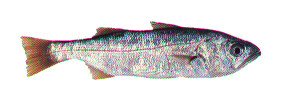Queen Umber
| Queen Umber | ||||||||||||
|---|---|---|---|---|---|---|---|---|---|---|---|---|

Queen umber ( Seriphus politus ) |
||||||||||||
| Systematics | ||||||||||||
|
||||||||||||
| Scientific name | ||||||||||||
| Seriphus politus | ||||||||||||
| Ayres , 1860 | ||||||||||||
The queenfish (hence the queen umber , Seriphus politus ) looks very little like the other umber fish - it is more like the Apogonidae . The belly and back lines are roughly the same length, as are the dorsal and anal fin. The forehead can be somewhat saddled. The trunk is pretty compressed. Rays: D1 IX-X, D2 I / ~ 20 (widely separated); A II / ~ 22.
This small, blue-silver schooling fish (only the fins are usually brown) occurs a relatively small distance on the coast of southern California (rarely British Columbia to Baja California), but is common and heard there because it is easy to fish goes to the most captured fish of the surf fishermen. He is max. 30 cm long. It can be fried, but is not one of the preferred food fish. At night it stays at depths of up to 150 m (especially above sandy soil), where it preyes on worms, crustaceans and smaller fish (its mouth is strikingly large), i. H. his stay during the day near the coast, especially at jetties, groynes, piers and stone embankments, protects him from the predators of the deeper water. Otherwise it differs little from the other Umbers.- Bes. around Australia, “Queenfish” is the name of the mackerel Scomberoides commersonnianus .

Web links
- Queen Umber on Fishbase.org (English)
- Seriphus politus inthe IUCN 2013 Red List of Threatened Species . 2 . Posted by: Chao, L. & Espinosa, H., 2007. Retrieved February 7, 2014.
annotation
- ↑ The generic name was taken from the Aegean island Seriphos , with which it has nothing further to do; however, there are said to have been frogs squawking loudly there, although the island hardly has any suitable waters! seriphos or serphos with the subsidiary form syrphos was also the (Greek) name of a fly or mosquito, from which Johann Christian Fabricius derived Syrphus (see Syrphidae ).